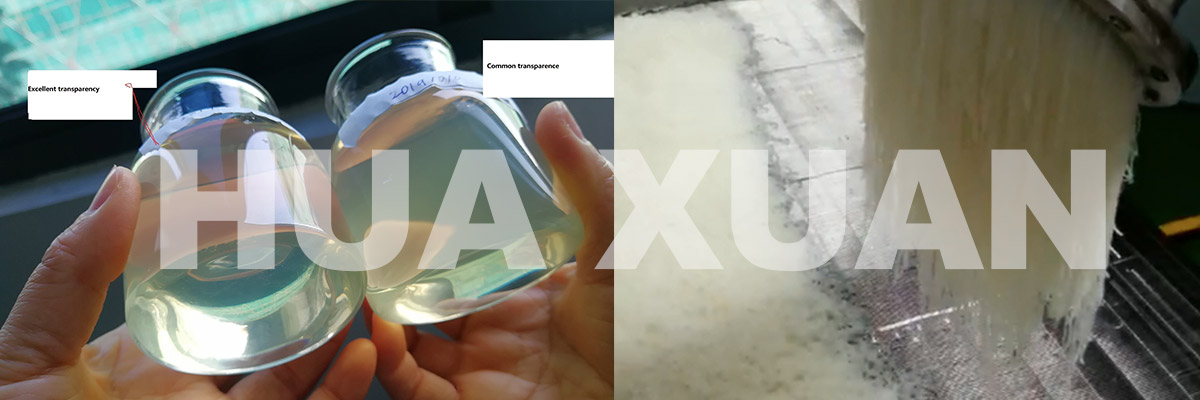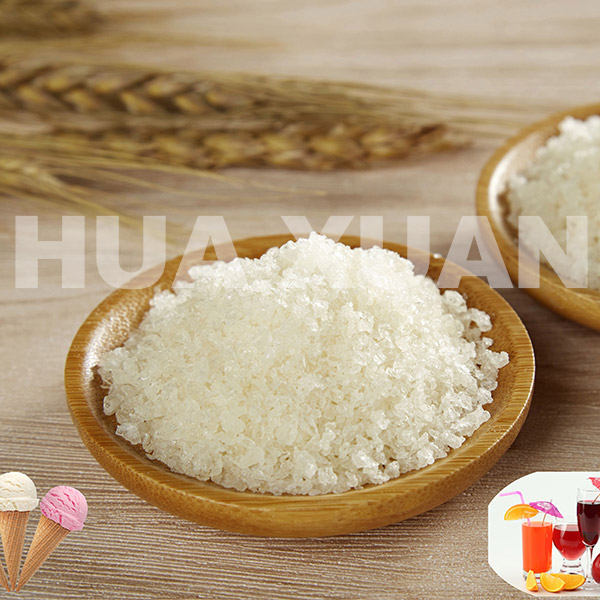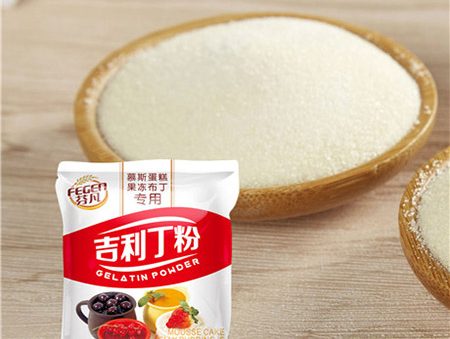
Fish skin gelatin wholesale
Fish skin gelatin is a partially hydrolyzed protein made from traditional mammalian animal products and by-products of meat processing. Because of its unique functional properties and reasonable price, it is widely used in the food and medical industries. fish gelatin derived from fish processing scraps has become a new alternative material for gelatin.
The article introduces the preparation method, flavor and freezing power, viscosity, emulsification, foaming and film-forming properties of fish gelatin. In addition, the purpose of summarizing its application in food, medicine and other industries is to provide a certain theoretical basis for the further development and utilization of fish gelatin.
Specification of fish gelatin
| Physics and Chemistry | Standard | Gelatin powder | ||||||
| Technical parameters/Glue strength (6.67%, 10℃) Bloom gram | 80-120 | 120-140 | 150-170 | 170-190 | 190-210 | 210-230 | 240-300 | |
| Viscosity | 2-5 mPa.s | 3.38 | 3.38 | 3.38 | 3.38 | 3.38 | 3.38 | 3.38 |
| Transparency (mm) | ≥50 | 300-500 | 300-500 | 300-500 | 300-500 | 300-500 | 300-500 | 300-500 |
| Ash content (%) | ≤2.0 | 0.9-1.5 | 0.9-1.5 | 0.8-1.0 | 0.8-1.0 | 0.8-1.0 | 0.6-1.0 | 0.6-0.9 |
| Moisture (%) | ≤14 | 5.97 | 5.97 | 5.97 | 5.97 | 5.97 | 5.97 | 5.97 |
| PH | 4.5-7.0 | 5.0-7.0 | 5.0-7.0 | 5.0-7.0 | 5.0-7.0 | 5.0-7.0 | 5.0-7.0 | 5.0-7.0 |
| Arsenic (mg/kg) | ≤1 | 0.1 | 0.1 | 0.1 | 0.1 | 0.1 | 0.1 | 0.1 |
| Arsenic (mg/kg) | ≤1.5 | 0.1 | 0.1 | 0.1 | 0.1 | 0.1 | 0.1 | 0.1 |
| Chromium (ppm) | ≤2 | 0.32 | 0.32 | 0.32 | 0.32 | 0.32 | 0.32 | 0.32 |
| Total number of colonies (Pece/g)≤ | ≤1000 | <10 | <10 | <10 | <10 | <10 | <10 | <10 |
| Escherichia coli | NO FIND | NO FIND | NO FIND | NO FIND | NO FIND | NO FIND | NO FIND | NO FIND |
| Salmonella | NO FIND | NO FIND | NO FIND | NO FIND | NO FIND | NO FIND | NO FIND | NO FIND |
The basic characteristics of fish gelatin
Gel strength and viscosity are important indicators to measure the quality of gelatin, and its flavor directly affects the development and application of gelatin.
1、Gel strength (jelly strength)
Gel strength is a measure of the hardness, stiffness, strength and compressibility of gelatin at a specific temperature, which are all affected by the concentration and molecular weight of gelatin. The gel strength of fish skin gelatin is positively correlated with the content of gel chains in fish skin gelatin, that is, the more d chain content, the higher the gel strength.
2、Viscosity of fish gelatin
The viscosity of gelatin is affected by temperature, concentration, pH, etc., while the concentration and type of acid have a significant effect on the viscosity of gelatin solution. With the increase of acid concentration, the viscosity of gelatin first increases and then decreases. Studies have found that when the concentration of acid is too high, it may increase the content of small molecular weight proteins in fish gelatin, thereby reducing its viscosity.
3、Flavor of fish gelatin
Almost all studies on the extraction and properties of fish gelatin show that, compared with land mammal gelatin, fish gelatin has a more or less fishy smell, and this smell limits its application to a certain extent. After research, it is found that fish gelatin can be denatured by modification, thereby reducing or eliminating its fishy. For example, the Japanese patent uses chemical modification to make fish gelatin derivatives not only retain the excellent properties of fish gelatin to moisturize and lubricate the skin, but also eliminate the fishy smell of fish. By studying the effect of melting temperature on the organoleptic properties of fish skin gelatin, it is found that compared with pig skin gelatin, fish skin gelatin is easier to release the desired flavor and aroma. Because fish skin gelatin can release the embedded volatile fragrance, it can be used for the development of new products.

The functional properties of fish gelatin
The functional properties of fish gelatin such as emulsification, foaming and film-forming properties are closely related to its application.
1、Emulsification of fish gelatin
Most gelatin solutions have no emulsifying properties. Only the skin gelatin prepared by the alkaline method exhibits a certain emulsifying ability when the concentration C>0.6%, while the fish skin gelatin can be used to make emulsifiers. Studies have found that even when the temperature, salt concentration, and pH value change, the fish gelatin emulsion can still maintain a certain degree of stability. That is, under normal circumstances, fish gelatin is relatively stable during the emulsification process.
However, by comparing the tuna fish gelatin emulsifier and the pig gelatin emulsifier, it is found that the stability of the tuna gelatin emulsifier is poor at the same protein concentration. By studying the molecular weight of fish gelatin and environmental factors such as pH, salinity, thermal processing and other environmental factors, it is found that the fish gelatin emulsifier is only below the salt concentration of 250mM sodium chloride solution. Heat treatment (30℃ and 90℃) Respectively treat within 30min), and it is relatively stable under the condition of pH (3~8). This shows that the use of fish gelatin emulsifier has certain limitations.
2、Foaming of fish gelatin
The foaming power of fish gelatin showed a steady upward trend with the increase of its solution concentration. From the point of view of the type of gelatin, the initial foaming force of fish skin gelatin solution is greater than that of the corresponding fish bone and scale gelatin solution; but the foam stability of fish skin gelatin solution is better than that of the corresponding fish bone and scale gelatin. The solution is much worse. So on the whole, the foaming power of fish bone and fish scale gelatin solution is better than fish skin gelatin.
In addition, fish gelatin can reduce the surface tension of the gas and liquid phases by increasing the phase viscosity of the solution to show a certain degree of foaming. This is mainly because the hydrophobic part of fish gelatin is adsorbed on the gas-liquid interface, and its area increases with the spreading and exposure of the protein, thereby promoting the formation and stability of the foam. Therefore, because fish gelatin contains high hydrophobic amino acid residues and viscosity, the use of it to prepare gelatin foaming agents has a good application prospect.
3、Film-forming properties of fish gelatin
Studies have reported that fish skin gelatin extracted with hot water has good film-forming properties. In addition, high-purity fish gelatin can be mixed with animal gelatin, and this mixture has better film-forming properties. However, the current research on fish gelatin protein membranes mainly focuses on large seawater fish such as seabass, tuna, walleye, and cod.
In recent years, some scholars have tried to prepare gelatin protein membranes from the skins of large freshwater fish such as channel catfish, and found that the mechanical properties of the protein membranes are not only superior to those of marine fish skin gelatin membranes, but even close to those of terrestrial mammals. .
The preparation method of fish gelatin
Fish gelatin is generally prepared by chemical or enzymatic methods.
1、 Chemical production of gelatin
Chemical method is the traditional preparation method of gelatin. It destroys the covalent and non-covalent bonds between the molecules of collagen fibers and the molecules through the action of acid or alkali, and releases the collagen molecules. Then the hydrogen bonds are broken by heating to prepare a gelatin solution, and then the gelatin solution is separated. Gelatin can be obtained by purification. At present, the acid method, alkali method, acid-base method, salt-alkali method and other chemical preparation methods are commonly used to prepare gelatin.
The grass carp skin was pretreated with hydrochloric acid with a concentration of 1.19% (v/V) for 24 hours, and the gelatin yield was 19.83%. The tilapia fish skin was processed with different concentrations and types of acids, and the fish skin gelatin was extracted. When optimizing the extraction process of Ankang fish skin gelatin, it was found that the best extraction process of gelatin is to use Ca(OH) with a mass fraction of 0.2%, extraction at 10°C, and liming for 7 days. The extraction rate was 11.23%.
After the dried tilapia skin was decolorized and swollen, the gelatin was prepared by boiling the gelatin in hot water. The results showed that the best extraction process is to soak in a 2.0% sodium hydroxide solution for 24 hours at a concentration of 0.3. Soaked in% hydrochloric acid solution for 4h, the boiling temperature is 80℃, and the boiling time is 8h. Under these conditions, the extraction rate of gelatin is 47.54%.
2、Enzymatic method of gelatin
No matter in the process or the equipment, the enzymatic hydrolysis of glue is a new method of making glue. The enzymatic production of gelatin not only shortens the production cycle of gelatin, but also reforms the traditional process of gelatin production, and has little pollution to the environment. Therefore, there are more and more researches on enzymatic gelatin production at home and abroad.
Enzymatic gel preparation is mainly a method of pretreating collagen with protease (pepsin, trypsin, papain, etc.) to partially degrade the collagen and then heat denature it to prepare gelatin. Although the main body of the collagen molecule remains intact under the protection of the triple-helical configuration, the non-helical peptide region, that is, the terminal peptide, is partially degraded by the protease, which reduces intra- and intermolecular cross-links and promotes the dissolution of collagen. Protease was used to study the extraction technology of snapper skin gelatin. The antibacterial properties of gelatin prepared by enzymatic hydrolysis of catfish bones were studied.
The background of fish gelatin
Introduction of gelatin
Gelatin, a common biopolymer, is the skin, bone, scale and other tissues rich in collagen of animals (such as cows, pigs, chickens, fish, etc.). After pretreatment and transformation, it is extracted at an appropriate temperature. Then process the resulting high molecular polypeptide polymer. There are generally more than 20 kinds of amino acids that make up gelatin, of which glycine accounts for 1/3, proline or hydroxyproline accounts for 2/9, alanine accounts for 1/9, and various other amino acids. Gelatin is connected by peptide bonds and is non-toxic and biodegradable. Its quality is generally determined by its freezing power and viscosity. The higher the freezing power and viscosity, the better the quality.
Brief introduction of fish gelatin
After research, it has been found that fish skin, fish bones, fish scales, fish swim bladder, etc. contain collagen similar to mammals, and fish gelatin can be extracted.
Application of fish gelatin
Because of its unique functional properties, fish gelatin can be used as a gelling agent, stabilizer, emulsifier, thickener, foaming agent, adhesive, clarifier, etc., widely used in food, medicine, photography, electronics and cosmetics industry.
Application of fish gelatin in the food industry
Fish gelatin has good application prospects in food processing. It can be used as food plasticizer, gelling agent, stabilizer, emulsifier, thickener, foaming agent, binder, binder, clarifier, etc. By comparing the sensitivity of porcine gelatin and fish gelatin to prepare hydrogels, it is found that foods made of fish scale gelatin have a lower melting point, and the melting rate and flavor release ability in the mouth are very ideal. Internationally, fish gelatin is recognized as the most advanced gel clarifier.
In the production process of beer and wine, fish gelatin is used as a sedimentation clarifying agent with good effect and the quality of the products obtained is very stable. Fish gelatin plays a role in thickening, emulsifying, stabilizing and clarifying in the wine brewing process.
In addition, fish gelatin contains relatively low calories, its gel melting temperature is lower than that of the oral cavity, and its taste is similar to fat, so it can be used to make low-fat foods.
The application of fish gelatin in the pharmaceutical industry
Fish gelatin collagen has weak antigenicity and biodegradability, and it has a coagulation effect on platelets, so it can be used to make heart valves, wound and burn repair materials, hemostatic agents, artificial skin, immobilized enzymes and extraction capsules. In addition, the mixed fish scale gelatin and other gelatins can also be used to make capsules, such as cod liver oil capsules and vitamin capsules. For drugs that need to appear in the intestines, enteric-coated capsules can be made.
Application of fish gelatin in photographic and electronic industries
Fish gelatin has a low gelation temperature. When used in photographic emulsions, the emulsification temperature is significantly reduced, and its particle size can be effectively controlled. It is reported that the particle size of the emulsion prepared with fish gelatin provides a new way to prepare ultrafine particle emulsions. In the electronics industry, fish gelatin can be used as a base for photosensitive coatings or photoresists.
Clarified fish gelatin was previously used as a water-soluble photoresist base. Some key components of color TVs, such as picture tubes, multi-hole masks, etc., are probably made using the photosensitive Rees printing process and matched with fish gelatin. Fish gelatin is also used in the lead frame that fixes the silicon chip in computers and micro-processing devices.
Application of fish gelatin in the cosmetics industry
After special processing, fish gelatin not only maintains its inherent excellent physical and chemical properties, but also improves its solubility in water due to the decrease in molecular weight, making it easier to be absorbed by the human body. Fish collagen can delay and reduce the generation of skin wrinkles, is beneficial to skin growth, can repair and nourish the skin, and can enhance the water retention capacity of skin cells. The cosmetic derivatives described in the patent are N-quaternary ammonium salt of fish collagen hydrolysate, N-acyl derivative or N. Silyl derivatives, the addition of these derivatives can play a very good lubricating and protective effect on the skin.
Summary of fish gelatin
In summary, scientists have conducted detailed studies on the structure, preparation methods, sensory properties, functional properties and applications of fish gelatin. Although there are still certain limitations in the technology and application of extracting fish gelatin, it is undeniable that we have seen the huge value and potential contained in them. As people continue to pay attention to the biomaterials market, it is believed that the functions and application fields of these gelatins will be enriched and improved to a greater degree in the future.
Gelatin powder and leaf gelatin
There are many types of gelatin. beef gelatin, gelatin powder & leaf gelatin.
Wholesale gelatin for capsules
Our wholesale gelatin is slightly yellow to yellow, transparent or translucent microstrip luster flakes or powder
Gelatin for candy – edible gelatin
In the food industry, edible gelatin is used as an additive in confectionery. Gelatin candy.
Halal beef gelatin powder
Gelatin have many usage. Gelatin have edible gelatin, industrial gelatin





